Hi Bridge, Hello Village
Comment via blog
Check Granny's letters of the day


|
Day 2: November 5, 2020 Hi Bridge, Hello Village Comment via blog Check Granny's letters of the day |
|
 
|
|
|
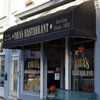 It was raining when Granddad and Granny reached Georgetown so they
"did not terry long" and did not discover the ten year old
Fava's Restaurant. I did and tarried for a bit over
breakfast.
It was raining when Granddad and Granny reached Georgetown so they
"did not terry long" and did not discover the ten year old
Fava's Restaurant. I did and tarried for a bit over
breakfast.
|
|
|
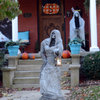
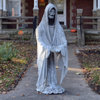 I even backtracked just a little to grab drive-by shots of some of the
cool Halloween decorations near the college.
I even backtracked just a little to grab drive-by shots of some of the
cool Halloween decorations near the college.
|
|
|
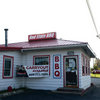 Not only has Red
State BBQ been voted the best in Kentucky, it has been personally
recommended. Even if I hadn't still been digesting breakfast, I couldn't
have sampled it this time as they were hours away from opening when I
passed. Next time.
Not only has Red
State BBQ been voted the best in Kentucky, it has been personally
recommended. Even if I hadn't still been digesting breakfast, I couldn't
have sampled it this time as they were hours away from opening when I
passed. Next time.
|
|
|

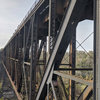


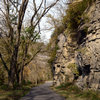
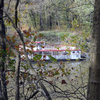 This is where Granddad and Granny did their "first bit of sight
seeing". The High Bridge of Kentucky is an impressive sight today
and it's hard to imagine how impressive it was to travelers a century ago.
It looked somewhat different then because the tall towers that had been
erected before the Civil War to support a suspension bridge were still
standing. They were removed in 1929 and a second track was added.
This is where Granddad and Granny did their "first bit of sight
seeing". The High Bridge of Kentucky is an impressive sight today
and it's hard to imagine how impressive it was to travelers a century ago.
It looked somewhat different then because the tall towers that had been
erected before the Civil War to support a suspension bridge were still
standing. They were removed in 1929 and a second track was added.
I had just parked and started to open my door when I heard a train whistle and hurriedly grabbed my camera and jumped out to grab a shot of the locomotive heading onto the bridge. If you think those bumps on the railing look like vultures, you'd be right. This must be a really good spot for them as there were lots around. The third photo was taken from an overlook to the east of the bridge that would not have been there in 1920. The remaining pictures were taken from Dix Road which passes under the bridge. The boat is sitting about where the ferry landed that cost the group $1.25 to get the two cars across in 1920. |
|
|

 In 1920, a bridge actually existed where I crossed the river today on
US-68, but it involved a lot of backtracking. Apparently our travelers
thought avoiding that was worth a buck and a quarter. They would not have
seen these businesses on the south side of the river even if they were
operating at the time.
In 1920, a bridge actually existed where I crossed the river today on
US-68, but it involved a lot of backtracking. Apparently our travelers
thought avoiding that was worth a buck and a quarter. They would not have
seen these businesses on the south side of the river even if they were
operating at the time.
ADDENDUM: Dec 31, 2020 - This video from History In Your Own Backyard identifies the fenced in site as the one time home of Chinn's Cave House, which may have been open in the 1920s but not when Granddad and Granny were in the area. |
|
|
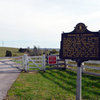
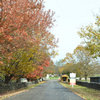 In 2001, we did no exploring on the south side of the river but I had
different intentions this time. I wanted to check out that "big long
pull up the cliff" Granny described. That meant I was was pretty
disappointed when I encountered this locked gate. I snapped a picture then
headed on to Shaker
Village of Pleasant Hill where I would be spending the night.
In 2001, we did no exploring on the south side of the river but I had
different intentions this time. I wanted to check out that "big long
pull up the cliff" Granny described. That meant I was was pretty
disappointed when I encountered this locked gate. I snapped a picture then
headed on to Shaker
Village of Pleasant Hill where I would be spending the night.
|
|
|




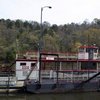 While checking in, my spirits lifted considerably when I learned that
guests were able to get a key to that gate. I briefly stopped by my room
then headed for the gate. I unlocked it, drove through, carefully locked
it behind me, and drove directly to the river side. The Dixie
Belle, an excursion boat belonging to the Village, has been idled by
the pandemic. I took a picture of it then began the two-mile "pull up
the cliff".
While checking in, my spirits lifted considerably when I learned that
guests were able to get a key to that gate. I briefly stopped by my room
then headed for the gate. I unlocked it, drove through, carefully locked
it behind me, and drove directly to the river side. The Dixie
Belle, an excursion boat belonging to the Village, has been idled by
the pandemic. I took a picture of it then began the two-mile "pull up
the cliff".
As I drove, I tried to imagine chugging up the hill in a 20 horsepower Model T that was probably in low gear all the way. Although the thought was somewhat romantic, I was quite appreciative of the extra power and even more appreciative of the pavement and guard rails that were not there for Frank. |
|
|

 This is my home for the night. There are three rooms plus the pictured
common area. The two upper rooms are empty so the whole place is more or
less mine although I spent all of my time
here.
This is my home for the night. There are three rooms plus the pictured
common area. The two upper rooms are empty so the whole place is more or
less mine although I spent all of my time
here.
|
|
|
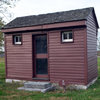
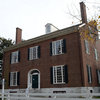
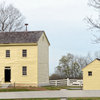
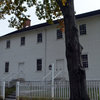
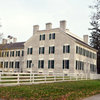
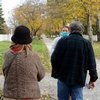 I availed myself of one of the free hourly tours and learned a lot about
the history of the village and many of the buildings in it. The first
building pictured is the largest in the village. Its name, Centre Family
Dwelling might not mean the same to you as it did to its nineteenth
century residents. Women occupied one side of the building and men the
other. Across the street is the Meeting House. The two yellow buildings
are northeast of the big dwelling house. The tallest is the water house
where pumps lifted water to a tank on the second floor where gravity moved
it to most buildings in the village. Next to it is the Brethren's Bath
House. The last two buildings pictured are the Trustee's Office and a
privy.
I availed myself of one of the free hourly tours and learned a lot about
the history of the village and many of the buildings in it. The first
building pictured is the largest in the village. Its name, Centre Family
Dwelling might not mean the same to you as it did to its nineteenth
century residents. Women occupied one side of the building and men the
other. Across the street is the Meeting House. The two yellow buildings
are northeast of the big dwelling house. The tallest is the water house
where pumps lifted water to a tank on the second floor where gravity moved
it to most buildings in the village. Next to it is the Brethren's Bath
House. The last two buildings pictured are the Trustee's Office and a
privy.
|
|
|
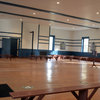
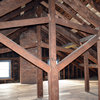

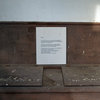 Following the tour, which is strictly an outside affair, I did some
self-guided exploring. The first picture shows the wide-open first floor
of the Meeting House. The second is of the uppermost floor where cleverly
designed trusses effectively transferred all the weight to the outer walls
to allow that pillar less first floor. Village residents not only likes to
shake it up, they would sometimes twist and shout. I really wanted to see
inside that water house but was thwarted by wet paint and yellow tape. The
six passenger privy is permanently closed off by clear plastic.
Following the tour, which is strictly an outside affair, I did some
self-guided exploring. The first picture shows the wide-open first floor
of the Meeting House. The second is of the uppermost floor where cleverly
designed trusses effectively transferred all the weight to the outer walls
to allow that pillar less first floor. Village residents not only likes to
shake it up, they would sometimes twist and shout. I really wanted to see
inside that water house but was thwarted by wet paint and yellow tape. The
six passenger privy is permanently closed off by clear plastic.
|
|
|


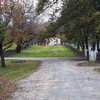
 At dinner time, I stepped out of my room and onto US-36 or I would have
back in the 1960s. I've driven by here several times and know that, while
you can see many of the Shaker buildings, they are some distance away.
Today I learned that this was the main road through the area until 1965
when it was rerouted, as US-36, to the south. The trees weren't there
then, and the right-of-way considerably wider, but it was still fairly
close to the buildings which it ran right through the middle of. Knowing
that gives a little different perspective to Granny's observation that
"Quakerton [a common misnomer] had nothing but large houses, it
looked like a college town."
At dinner time, I stepped out of my room and onto US-36 or I would have
back in the 1960s. I've driven by here several times and know that, while
you can see many of the Shaker buildings, they are some distance away.
Today I learned that this was the main road through the area until 1965
when it was rerouted, as US-36, to the south. The trees weren't there
then, and the right-of-way considerably wider, but it was still fairly
close to the buildings which it ran right through the middle of. Knowing
that gives a little different perspective to Granny's observation that
"Quakerton [a common misnomer] had nothing but large houses, it
looked like a college town."
|
|
|
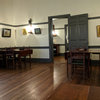



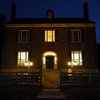 The Trustee's Office is where the restaurant now is so I saved checking
out its interior until meal time. The first shot is from my table where I
enjoyed this incredibly good trout. I certainly
don't associate spiral stairways with Shakers but this building has a pair
of them. They were so cool that I decided they deserved having three
pictures included. The sun had set while I was eating so I stepped outside
to a different view and a very pleasant walk back to my stone house.
The Trustee's Office is where the restaurant now is so I saved checking
out its interior until meal time. The first shot is from my table where I
enjoyed this incredibly good trout. I certainly
don't associate spiral stairways with Shakers but this building has a pair
of them. They were so cool that I decided they deserved having three
pictures included. The sun had set while I was eating so I stepped outside
to a different view and a very pleasant walk back to my stone house.
|
|
|
| [Prev] [Site Home] [Trip Home] [Next] |